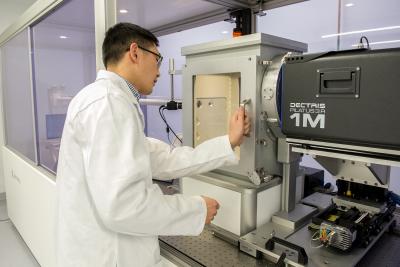Federal Grant Helps USM Researchers Secure Tool to Study Ballistics Protection
Tue, 12/12/2017 - 10:53am | By: Van Arnold

Groundbreaking research being conducted in polymer science labs at The University of Southern Mississippi could lead to enhanced protective wear for United States warfighters.
A $4.9 million grant provided by the U.S. Army Research Laboratory (ARL) has enabled the School of Polymers and High Performance Materials to acquire a state-of-the-art Xeuss 2.0 Small-Angle/Wide-Angle (SAXS/WAXS) scattering system. Developed by the Xenocs Company, the Xeuss 2.0 system enables high performance measurements that were previously limited to synchrotrons.
The grant is part of a $20 million, two-year collaboration between USM, Temple University, the University of North Texas, and the University of Southern California to develop ballistic protection applications.
USM polymer Professor Dr. Jason Azoulay serves as Co-Principal Investigator on the grant, titled: “Advanced Ballistics Technology Material Development.” Azoulay notes that the grant funding will allow rapid design, development, measurement, testing, modeling and prototyping for strategic areas of interest determined by ARL researchers.
“Some of these would include armor packages, vehicle anti-blast countermeasures, lightweight armors, protective structures, and kinetic energy active protection to better protect the warfighter from injuries and trauma associated with various ballistic and blast loading events as compared to traditional energy absorption materials,” said Azoulay.
Azoulay's research colleague Dr. Xiaodan Gu pointed out that USM is the only university in the Southeast region that has the Xeuss 2.0 system. He emphasized that this type of research and development serves to fortify the University's reputation as a global leader in polymer science.
“With this type of technology we are able to view and study features that are 1/10,000th the size of a human hair,” said Gu. “This X-ray scattering system allows us to examine the architecture of polymers and respond accordingly. This is all necessary for us to design materials at the molecular level.”
Dr. Olivia D. McNair, Manager of Pneumatic Materials Science and Engineering Programs, says that the SAXS/WAXS system offers a unique opportunity for USM researchers to explore the unseen connections between polymer nanostructure and performance.
“By probing small scale phenomena such as crystal structure and domain spacing and how it changes under loads, it is possible to understand the underlying mechanisms responsible for energy absorption,” said McNair. “SAXS/WAXS analysis completes the picture of what are truly important factors when paired with more traditional polymer evaluative techniques.”
Essentially, says McNair, researchers can begin to target or predict materials that will demonstrate the best performance for ballistic applications.
Dr. Jeffrey Wiggins, Director of the School of Polymers and High Performance Materials and Principal Investigator of the grant, says that the funding's implications stretch far beyond USM's research laboratories.
“With grants of this nature, we are not only conducting transformative research, but also educating and training an entire generation of future scientists,” said Wiggins. “Our faculty and students are teaming up to study and develop materials that will have broad applications across the globe. And during the process, new and exciting curriculums will be developed in our polymer science/engineering programs.”
To learn more about the School of Polymer Science and Engineering, call 601.266.4868 or visit: https://www.usm.edu/polymer
